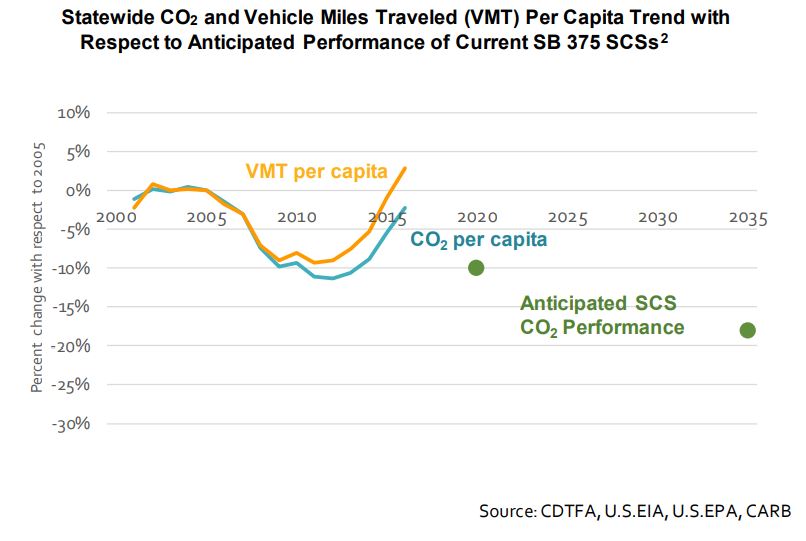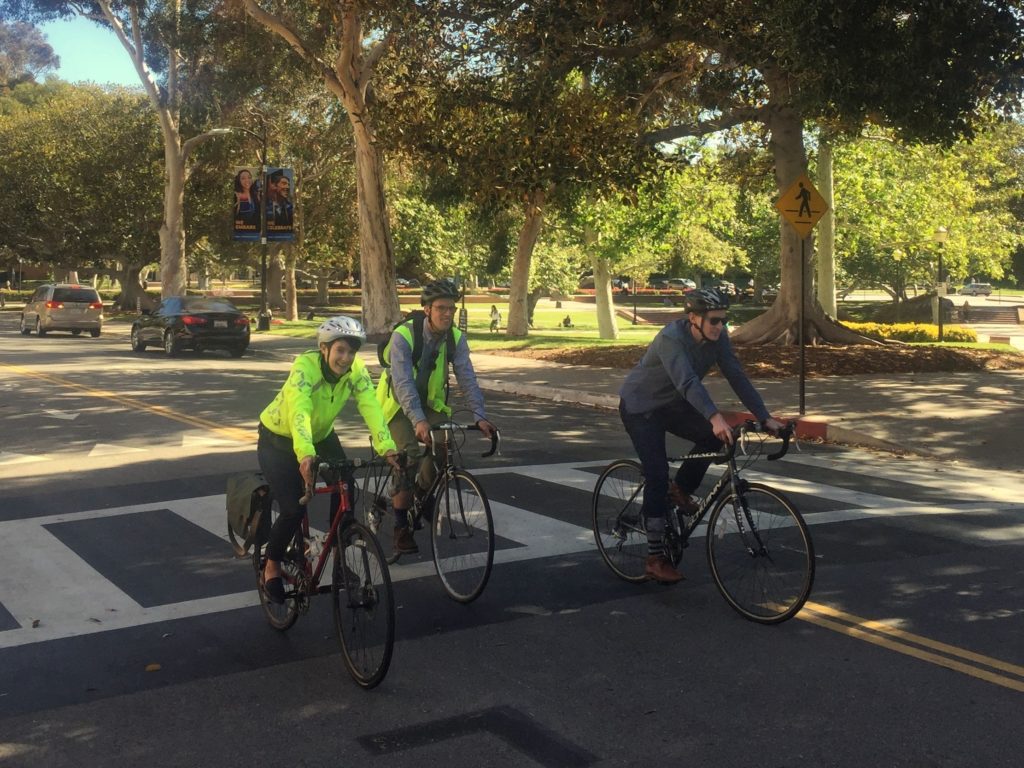We’re Never Going to Meet Our GHG Transportation Goals Unless We Radically Rethink Our Cities
Legal Planet: Environmental Law and Policy 2018-12-05

I’ve been thinking a lot lately about vehicle miles traveled, or VMT. Specifically, why is it so hard to get people to think seriously about reducing VMT as a climate mitigation strategy? Building on my earlier ode to electric scooters, this post begins a semi-regular series on different aspects of VMT reduction strategies, beginning with an introduction today to VMT and its relationship to climate change goals.
We know that the transportation sector is now the biggest contributor to GHGs across the country, and especially here in California. But conversations on reducing transportation emissions have been dominated in recent decades by electrification and fuel economy. Just last month, Jerry Brown said better battery technology was “the only way” to meet our transportation goals.
And sure, when we’re all driving zero-emission vehicles that plug into a zero-carbon grid, our transportation emissions will indeed be extremely low carbon. But here’s the thing: that future is a long way off. California’s ZEV mandate calls for only about 8% of new vehicle purchases to be ZEVs by 2025–and that’s just new vehicles. The average car sold today will be on the road for at least 11 years, locking in a decade plus of GHG emissions for every non-ZEV sold. In addition to our long-term electrification plans, we have to focus on strategies to reduce emissions from those non-ZEVs in the near term by getting them off the road.
As Ethan noted this morning, VMT reduction has to be top priority on Governor-elect Newsom’s agenda. This is both because getting people out of their cars is crucial to meeting our climate goals, but also because we’ve been exceptionally bad at it so far. CARB recently released a ground-breaking report on California’s progress in implementing the sustainable community strategies from SB 375, the 2008 law designed to integrate transportation, housing, and land use decisions with the state’s climate goals. Turns out, people have been driving more over the last five years, rather than less:
 As you can see from the above chart, California is nowhere close to meeting the 2020 per capita greenhouse gas reduction goals, and even worse, is headed in the wrong direction with per capita VMT on a dramatic upward trend. The key takeaway from CARB’s report:
As you can see from the above chart, California is nowhere close to meeting the 2020 per capita greenhouse gas reduction goals, and even worse, is headed in the wrong direction with per capita VMT on a dramatic upward trend. The key takeaway from CARB’s report:
“With emissions from the transportation sector continuing to rise despite increases in fuel efficiency and decreases in the carbon content of fuel, California will not achieve the necessary greenhouse gas emissions reductions to meet mandates for 2030 and beyond without significant changes to how communities and transportation systems are planned, funded, and built.”
So how do get better at encouraging people to drive less? The kinds of changes that result in people leaving their cars at home are a lot more complicated than simply adding new bike lanes (and of course, here in LA, even adding bike lanes isn’t exactly a painless process).
How do we ensure the owner of that non-ZEV that’s going to be on the road for the next decade can afford to live close enough to their workplace to make commuting by car an option, rather than a requirement? How do we provide safe, convenient, and affordable low or zero-carbon modes of transport like public transit, walking, biking, and scooting to get that non-ZEV owner to and from their child’s school? To the grocery store, the library, the movies? How do we retrofit our cities to create dense, walkable, transit-oriented neighborhoods where residents don’t need to own cars at all? Can we do any of this in an equitable way that avoids displacement? Can public transit systems be designed to get middle class drivers out of SUVs while still fulfilling their social service need to help a city’s most vulnerable populations? Should they be? 
There are no easy, cookie-cutter answers to these questions. Decisions about land use, housing, and transportation require difficult choices and a lot of political will by a lot of different levels of government. For example, it took a 2017 bill (AB 179) to force CARB and the California Transportation Commission to coordinate on these issues. Yesterday, the agencies in charge of our state’s climate planning and transportation planning met for just the second time. Ever.
This is part of why VMT reduction doesn’t tend to be discussed in any particularly coherent way–the kind of coordination that’s required necessitates truly transformative change, at every level of government and at the level of individual behavior.
But here’s the thing: we can’t afford to ignore significant climate mitigation measures just because they are politically difficult.
The IPCC’s recent bombshell report notes that “demand-side mitigation and behavioural changes” are going to be needed to avoid the worst climate change impacts. Transportation mitigation pathways for limiting global warming to less than 1.5 degrees require not just “[t]echnology-focused measures,” but also strategies based on “[s]tructural changes that avoid or shift transport activity” that have “received lesser attention in most global transport decarbonisation pathways up to now.”
CARB’s 2017 AB 32 Scoping Plan Update called for a suite of options to reduce VMT, noting that reducing VMT is a “necessary” part of meeting the state’s 2030 and 2050 GHG goals. The following selection from the Scoping Plan Update’s lists of VMT strategies and goals illustrates just how ambitious and transformative our thinking has to be:
- Quadruple the proportion of trips taken by foot by 2030 (from a baseline of the 2010–2012 California Household Travel Survey).
- Strive for a nine-fold increase in the proportion of trips taken by bicycle by 2030 (from a baseline of the 2010–2012 California Household Travel Survey).
- Strive, in passenger rail hubs, for a transit mode share of between 10 percent and 50 percent, and for a walk and bike mode share of between 10 percent and 15 percent.
- 15 percent reduction in total light-duty VMT from the BAU in 2050
-
Continue to develop and explore pathways to implement State-level VMT reduction strategies. . . through transparent and inclusive interagency policy development process to evaluate and identify implementation pathways for additional policies to reduce VMT and promote sustainable communities, with a focus on:
- Accelerating equitable and affordable transit-oriented and infill development through new and enhanced financing and policy incentives and mechanisms,
- Promoting stronger boundaries to suburban growth through enhanced support for sprawl containment mechanisms such as urban growth boundaries and transfer of development rights programs,
- Identifying performance criteria for transportation and other infrastructure investments to ensure alignment with GHG reduction goals and other State policy priorities and expand access to transit, shared mobility, and active transportation choices,
- Promoting efficient development patterns that maximize protection of natural and working lands,
- Developing pricing mechanisms such as road user/VMT-based pricing, congestion pricing, and parking pricing strategies,
- Reducing congestion and related GHG emissions through commute trip reduction strategies, and
- Programs to maximize the use of alternatives to single-occupant vehicles, including bicycling, walking, transit use, and shared mobility options.
So, super easy to-do list for the state right?
As I noted, this post is intended to be an introduction to VMT and climate mitigation. Given the coordination problems described above, I hope to use this series to highlight the ways in which wonky transit and urbanism issues should be considered climate mitigation and to think deeper about reducing our transportation emissions from a holistic perspective, all while centering the equity issues that must be key to our approach going forward.
Coming soon: tales from a car-less Angeleno; local opposition to road diets; declining transit ridership and neglected bus lines; and digging into this year’s crop of YIMBY densification proposals in the new legislative session (some of which Ethan has already previewed here). My goal with this series is to encourage conversations, so tweet at me with inspiration and questions!
For further reading, here are some recent stories that have caught my eye:
- Alissa Walker, When electric isn’t good enough: Sacramento is the staging ground for a fight to make drivers spend less time on the road, Curbed (Oct. 24, 2018), https://www.curbed.com/a/texas-california/electric-cars-climate-change-sacramento-california
- LA Times Editorial Board, California talks a good game on land-use and climate change, but it’s still a land of SUVs and sprawl (Nov. 29, 2018), https://www.latimes.com/opinion/editorials/la-ed-housing-transportation-climate-20181129-story.html
- Patrick Sisson, Can Minneapolis’s radical rezoning be a national model?, Curbed (Nov. 27, 2018), https://www.curbed.com/2018/11/27/18113208/minneapolis-real-estate-rent-development-2040-zoning
- Carolina A. Miranda, Meet the anonymous artist installing bus benches at neglected stops on L.A.’s Eastside, L.A. Times (Nov. 28, 2018), https://www.latimes.com/entertainment/arts/miranda/la-et-cam-anonymous-bus-bench-artist-20181128-story.html
- Dave Alpert, Scooters are taking cars off the road, a survey says, Greater Greater Washington (Oct. 25, 2018), https://ggwash.org/view/69621/scooters-are-taking-cars-off-the-road-a-survey-says
- Angie Schmitt, Study: Dockless Mobility More Popular with People of Color in D.C., StreetsBlog (Nov 16, 2018), https://usa.streetsblog.org/2018/11/16/study-dockless-mobility-more-popular-with-people-of-color-in-d-c/
- Eillie Anzilotti, The city of the future is one with way less parking, FastCompany (Nov. 29, 2018), https://www.fastcompany.com/90273563/the-city-of-the-future-is-one-with-way-less-parking